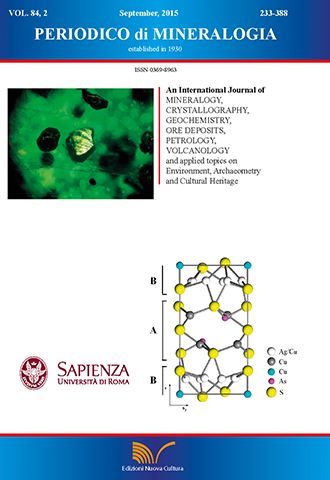Egyptian Smectite-Rich Clays for Lightweight and Heavy Clay Products
DOI:
https://doi.org/10.2451/2015PM0018Keywords:
Ceramic, Lightweight aggregates, Clay Products, Eocene, EgyptAbstract
Suitability of three technological samples representing smectite-rich clay deposits of El-Minya, Egypt for lightweight and heavy clay products was studied. According to particle-size, mineral, and chemical composition of the clay samples, one sample was rejected due to its high content of sulphate gypsum and anhydrite minerals. Ceramic properties before firing of a sample representing the other two clays with and without addition of 40% sand grains were studied. These include rate of slaking in water and water of plasticity as well as linear drying shrinkage and drying sensitivity coefficient (DSC). The representative clay sample without addition of sand grains was assessed for lightweight bloated clay aggregate by processing its plastic pellets up to firing at 1000-1300oC. Also, suitability of shaped plastic clay-sand bodies for heavy clay products was studied after firing up to 800-1200oC by following their densification parameters in terms of total linear shrinkage (TLS), bulk density (BD), water absorption (WA), and crushing strength (CS). Efflorescence test was also conducted to follow up deposition of any white water-soluble sulphate salts on surfaces of the wet fired bodies after drying. The three samples of El-Minya clays contain major clay particles and lesser silt and sand particles due mainly to its high content of smectite with lesser kaolinite and illite clay minerals. In addition, variable quartz, feldspar, and hematite as well as gypsum and anhydrite non-clay minerals are detected and one of these samples was rejected due to its high content of the latter minerals. The representative sample of the other two clays is of a low-grade due mainly to its low-alumina as well as high silica and fluxing oxide contents. When 40% of sand grains was added to the clay sample, water of plasticity is decreased from ~51 to 25% and LDS as well as DSC were reduced from 13.3 to 8.1% and from 1.4 to 0.92, respectively. Furthermore, the shaped 60/40 clay/sand bodies were partially and fully vitrified after firing for 2 hours up to 1000 and 1200oC, respectively. The partial and fully vitrified bodies show accepted WA, TLS, BD and CS levels, according to the Egyptian and International standards for building bricks and ceramic tiles, respectively. The fired bodies were also classified as "not-effloresced" types after testing for efflorescence. In addition, the clay sample was also processed as lightweight bloated clay aggregate with grain density of 0.7-0.8 g/cm3 after firing up to 1300oC. This is mainly attributed to developing of sufficient amount of a silicate liquid phase viscous enough to entrap the oxygen gas, simultaneously evolved due to partial reduction of Fe2O3 of the clay into FeO with the formation of magnetite (Fe3O4) spinel.


